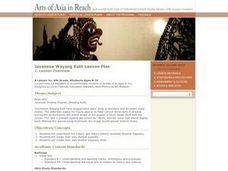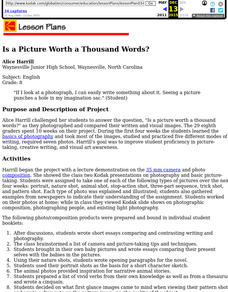Curated OER
Connecting Rembrandt and J.R. Tolkien
Students trace continuous thread of art from the 17th to the 20th century. They compare and contrast the painter Rembrandt with the writer Tolkien. They prepare and deliver an individual presentation.
Curated OER
Writing Directions for Mathematical Activities
Fifth graders reorganize comic strips to have them make sense, complete outline and organize their thoughts into outline form to explain directions,
and use that outline to complete their own directions for geometry activities.
Curated OER
For Sale! Part 2
Students use storyboarding software to create a storyboard for a movie about selling their school building. They use the storyboarding software as a tool to organize the different shots or scenes that will appear in their movie.
Curated OER
Sound Stretching
In this basic vowel and consonant blending lesson, young learners are shown how to "blend" the sounds of different letters together in order to make a word. Simple words such as, "sun," "moon," and, "ant," are used in a whole-class setting.
Curated OER
Hands and Feet of Many Colors
Students perform activities that involve color and shape discrimination. They play games to practice memory skills. Students recognize body parts to participate in activities.
Curated OER
Save the Music Concert: Part 2 Composition
Students examine why music is considered to be the "universal language" and study the expressive quality of a musical performance. They compose a melody using a computer and software which they perform on an instrument.
Curated OER
Wild Things Are Here
Students engage in a literature study for the book Where The Wild Things Are. The skill of prediction is practiced as they preview the story as a whole class. The teacher models reading fluency, pronunciation, and phonetic skills while...
Curated OER
Lost and Found
Students listen to the story "Arthur Lost and Found," and relate to the situations in the story to their own lives. In this reading comprehension lesson plan, students have a class discussion which leads them to more closely examine what...
Curated OER
Poetry
Fourth graders participate in reading and listening to poetry. They are exposed to a variety of poems and examine and identify basic elements of poetry. They write their own poems and recite a poem with enthusiasm, expression, and props.
Curated OER
W Is For Wyoming
Students engage in a lesson about the state of Wyoming. They complete a worksheet looking for facts and identify some common symbols used to represent the state. The symbols are used to practice sounds and give context to class discussion.
Curated OER
Coal and Oil: Powering Our Way of Life
Students identify and represent some common products that are made using petrochemicals and some of the effects that higher gasoline and coal prices would have on the American economy in a graphical format. They synthesize information...
Curated OER
Javanese Wayang Kulit Lesson Plan
Fourth graders study the history and culture associated with Javanese Shadow Puppets and the perspective that is used during performances. They design original shadow puppets and give a shadow puppet performance using their creations.
Curated OER
Cinquain
Students create an original Cinquain (five-line poem) and choreograph movement to their poem, performing movement for class and video. This lesson addresses standards in the arts and requires a video recorder.
Curated OER
Let's Meet Famours Painters!
Students demonstrate an understanding of art terms and concepts by analyzing and interpreting visual art forms that are paintings from world cultures. They practice art criticism after working on vocabulary.
Curated OER
Hey, Mom! What's for Breakfast?
Students examine how he world eats breakfast. In this food choices lesson, students work in groups to list breakfast foods and their ingredients and find goods and consumers on the list. The, students use the Internet to complete a...
Curated OER
Touring the Regions of the United States
Fifth graders explore the regions of the United States. In this geography skills lesson, 5th graders examine the landforms, climates, and economies of the regions of the United States. Students conduct Internet research in order to...
Curated OER
Simple Sequencing
Fourth graders play a stand up version of musical chairs to find their sequencing partners. In this music and language arts lesson, 4th graders enjoy a game that requires them to organize a series of three pictures, then write sentences...
Curated OER
Sorting and Graphing Animals
Students inquire about animals using SIRS Discoverer or eLibrary Elementary. In this organizing data lesson, students sort pictures of animals in various ways and develop graphs. Students locate a mammal, reptile, fish, insect or bird...
Curated OER
I Nominate My Friend
Students review letter writing skills and the use of descriptive language, and practice writing persuasive letters, with help from teacher and peers. Letters are then written to nominate friend for Friend of the Year.
Curated OER
Between the Lions: Exploring Short-Vowel Sounds
Students review the short sounds of a, e, i, o, and u previously discussed in class. They read and be able to identify words that have short-vowel sounds and become familiar with the basic navigational features of a website.
Curated OER
Shakespear Scavenger Hunt
High schoolers use the internet to study basic biographical facts about Shakespeare in the form of an internet scavenger hunt. This activity is a great introduction to a Shakespearean unit of study.
Curated OER
Geo Jammin' By DeSign - Day 2, Lesson 10: Wanna Trade?
Learners listen to a book that facilitates a discussion of trade and things that people need. They determine what things might be traded.
Curated OER
Let's Play Scrabble!
What do Alfred Mosher Butts, James Brunot, and Jack Straus have in common? They were all instrumental in the development of Scrabble. Class members will discover these facts and many more as they conduct a WebQuest to gather, organize,...
Curated OER
Is a Picture Worth a Thousand Words?
Eighth graders study the basics of photography and practiced five different modes of writing, required seven photos.

























